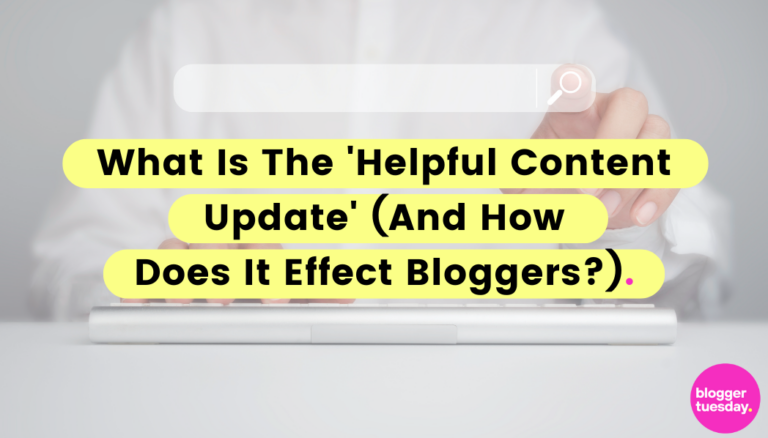How you rank on Google will influence how people find your site, and how many leads you can generate. Google announced the Helpful Content update in 2022, with the update rolling out just a week later. The effects, however, are going to be seen gradually, as data feeds the algorithm over time. As this is the first big update since the Brand Core update, it’s important to delve into it as a blogger, because it could mean that you need to make some changes to the way you write your posts.
Google’s Take on the Helpful Content Update
Google has explained that their goal is to try and tackle content that’s created to rank, rather than content that’s been created to help people find the information they need. In other words, they don’t want people to create articles that are keyword-stuffed. As a result of this, if you provide content that is helpful for search engines, then great. If you’re providing content that’s written to gain a higher ranking in the SERPs, then you need to change your approach.
According to Google, the purpose of the update was to try and introduce a new ranking signal. Google can now automatically identify content that has little value, or low-added value. They are also targeting content that is not helpful to humans, or in other words, content that’s written just for search engines. In an article posted by Google, they outlined the following points to help bloggers make the most out of their posts.
- Ensure content is valuable and useful
- Demonstrate first-hand expertise
- Showcase deep knowledge
- Have a clear purpose
- Content should be engaging and positive
Google also introduced a classifier, which caused rankings to go down for sites that had significant amounts of unhelpful content. The classifier ranking impact varied, depending on how much unhelpful content a website had. In 2023, Google then launched a Helpful Content Update. This led to a huge decline in sites across several categories. Many lost up to 50% of their visibility.
Sites that were Hit the Hardest in 2023 by the Update
Google specifically targeted sites that had the following, in the 2023 update.
- Excessive ads
- Vignette ads and auto-play video ads
- Excessive affiliate links without substantial content
- Insufficient E-E-A-T content with no author biographies
- Excessive SEO patterns
- Low-quality product review sites
- Low-quality pages
- Stock photos or stolen images
- AI-generated strategies
- Heavy AI content with no value
Google’s Helpful Ranking System and the March 2024 Update
Moving forward to the March update, Google made several changes to its core systems. They also evaluated the helpfulness of the content. As part of this update, Google depreciated the ranking system. It’s now no longer one system with one classifier. It’s been incorporated into the core ranking algorithm, which helps to show more satisfying and helpful content. Google has also gone as far as to add an FAQ page, which relates to the Helpful Content Update and the ranking system. It explains that the core ranking system is going to show more helpful results using a wide variety of innovative signals, rather than using a single approach.
How to Create Helpful Content as a Blogger
If you want to make your blog the best it can be, then you need to ultimately create helpful content. Creating content that satisfies algorithms and bots is like walking a fine line. You need to balance authenticity, relevance, and quality. If you want to align your blog with the 2024 update, then you need to adopt a holistic approach. Consider the depth of information, presentation, and most importantly, user experience. You can find some guidelines by Google, below:
Experience
Share any personal experiences you might have had and take the time to add case studies. Give your content perspective and enhance credibility where possible. Provide value to your users, and make sure that your content is as engaging and as authentic as possible. Be real, and get personal.
Authority
Cite your sources, link to research, and maintain a consistent record of linking and mentioning quality publications. Remember that authority can also be enhanced through mentioning other authoritative figures in the sector.
Trust
Secure trust by being transparent about who your sources are and by making sure that your content is accurate. Include disclaimers where you’re unsure, and maintain a level of integrity and trust within your content.
Focus on the User
Think about why the user clicked on your post. Take the time to address their needs and answer questions. Tailor your content so that it meets their queries comprehensively, and go in-depth with topics rather than skimming the surface. You also need to create content that is engaging, and visually appealing. Structure your text with bullets and headings, using images to break up complex information.
Be sure to align your content with user intent. Are your users looking to solve a problem? Are they trying to make a purchase but need more information? Or are they looking for a solution? If you can consider things like this, it becomes easier to provide a direct solution.
Avoid Clickbait and Ads
Clickbait will be the death of your site. Take the time to avoid misleading headlines that promise far more than what the content provides. Create titles that reflect the depth of the content you are writing, and don’t use titles like “ultimate guide” if your content is only 500 words.
Ads are also another thing you need to watch out for. Take the time to minimise any pop-ups you may have and also don’t detract from the user experience. That’s not to say that you can’t have ads, but you do need to make sure that they don’t take away from the experience of the user.
Ownership and Authorship
Identify authors and list contributors. Things like this establish credibility, something that Google is very much focused on right now. Include links to professional profiles, and add bios. Transparency is everything right now, so try and be open about the purpose of your content, and state whether you have any commercial interests that could be influencing the creation of it.
AI-Generated Content
There’s no questioning that AI has become more sophisticated with each passing year. AI-generated content has also become way more prevalent across the web. Google’s stance on AI has more to do with the quality and accuracy of the content it produces, as opposed to its origin. AI-generated content isn’t necessarily penalised by Google, but it’s not favoured either. Google expressed concerns about AI generating content that mimics the quality of other blogs, without providing value. This could lead to content that is competent from a technical standpoint, but in reality, it lacks any original insight. It also lacks the nuanced experience that human-generated content offers.
For this reason, you can use AI to write content, and there’s nothing wrong with that. With that being said, if you want to get the best result out of your writing and your blog, then using AI as a way to aid research is the way to go. Implement human oversight and editing, and make sure that you fact-check everything. Enrich it with human experiences that AI is unable to add on its own, and make sure that you also take the time to align it with user intent.
Disclose that you’re using AI in content creation if you feel as though it significantly influences the nature of the content you are providing. Lastly, transparency can help mitigate any potential trust issues when it comes to authenticity, so make sure that you consider this and be as open as possible. When creating content at scale, AI can be useful, but human involvement is the key to making sure that your content is valuable and useful as a blogger.
Dealing with Unhelpful Content
As a blogger, there’s a chance that you have some unhelpful content on your site. This could be negatively impacting your search engine ranking.s If you want to do something about this then you need to go back and update content that is outdated, or superficial. You also need to add comprehensive detail and information where it is lacking. Update statistics, include recent developments, and be sure to expand sections that you feel are underdeveloped. Optimise for the best SEO practices, and improve the experience. Ascertain that your content is friendly to mobile users, and improve the layout, or enhance visual elements where required. When deleting low-quality content, use redirection as a way to ensure you’re still receiving search engine traffic.
This helps you to preserve link equity and it is a fantastic way for you to guide your users to more helpful content overall. Of course, the recent Helpful Content Update has been a bit of a blow to some bloggers, it is a step forward for those who take pride in their work, and who want to provide users with informative and helpful content. By keeping this core message at the heart of your blogging, you will soon find that you stand to benefit from the update and that your site experiences a surge in ranking as a result of a few minor changes.


